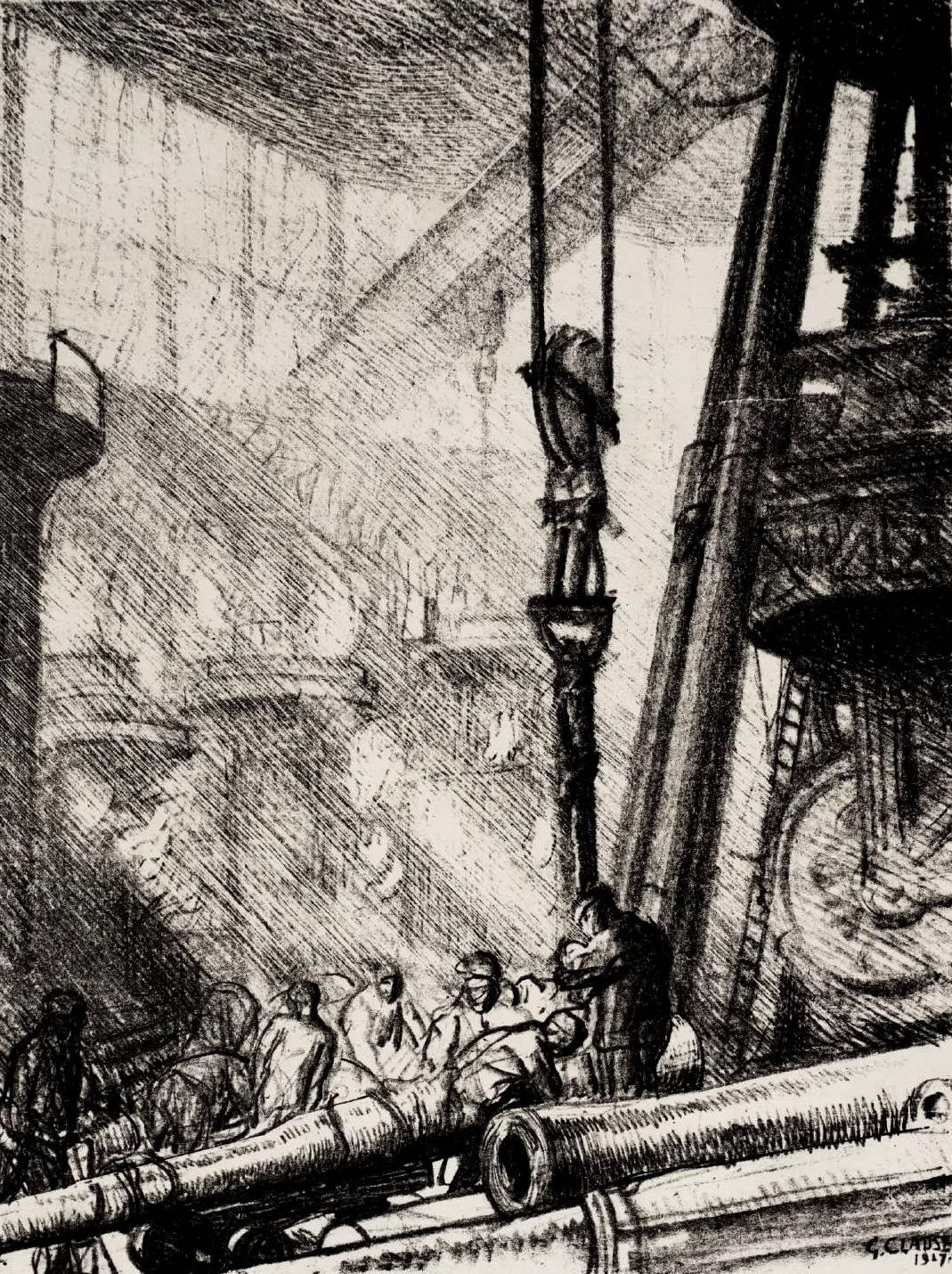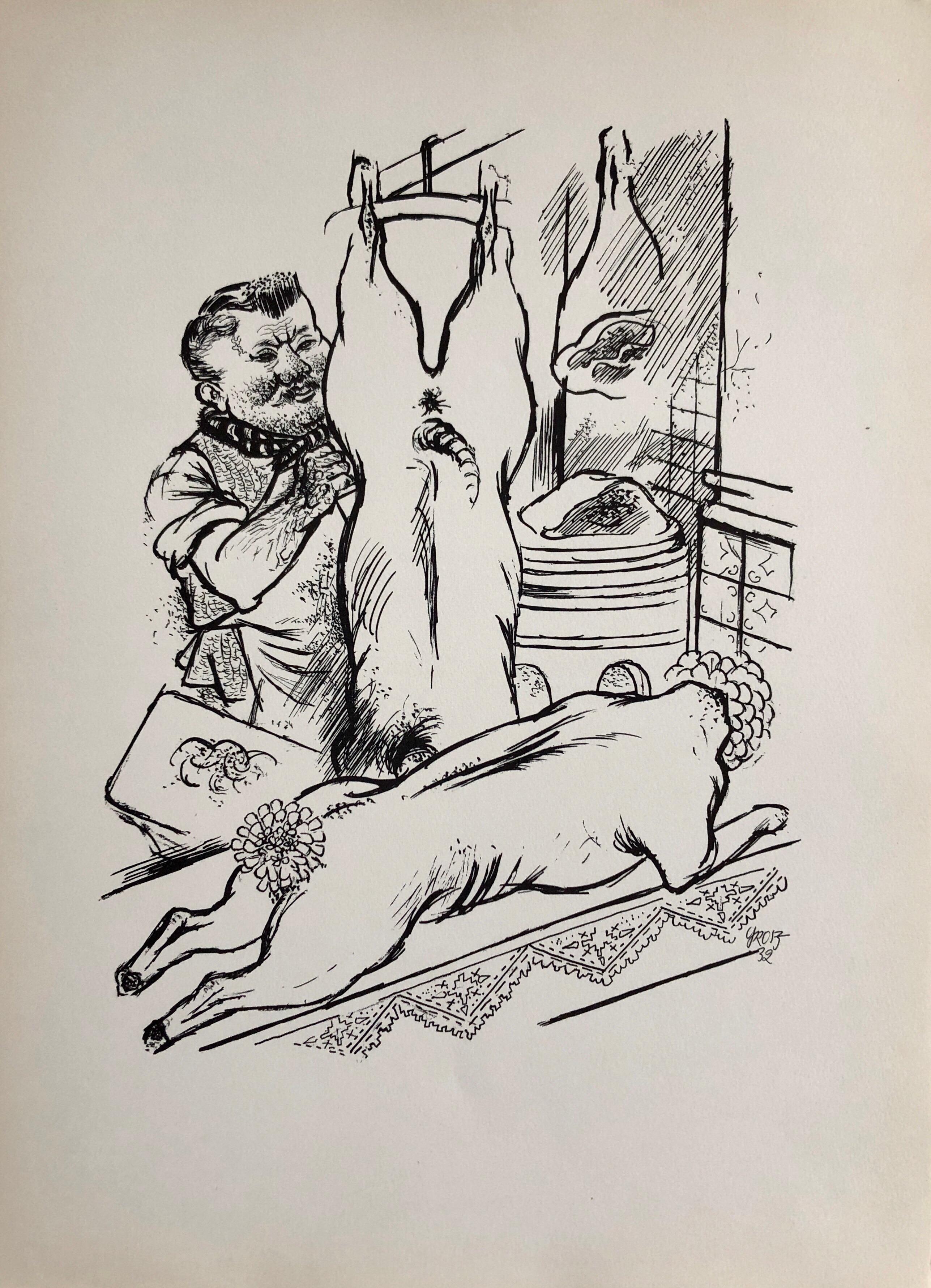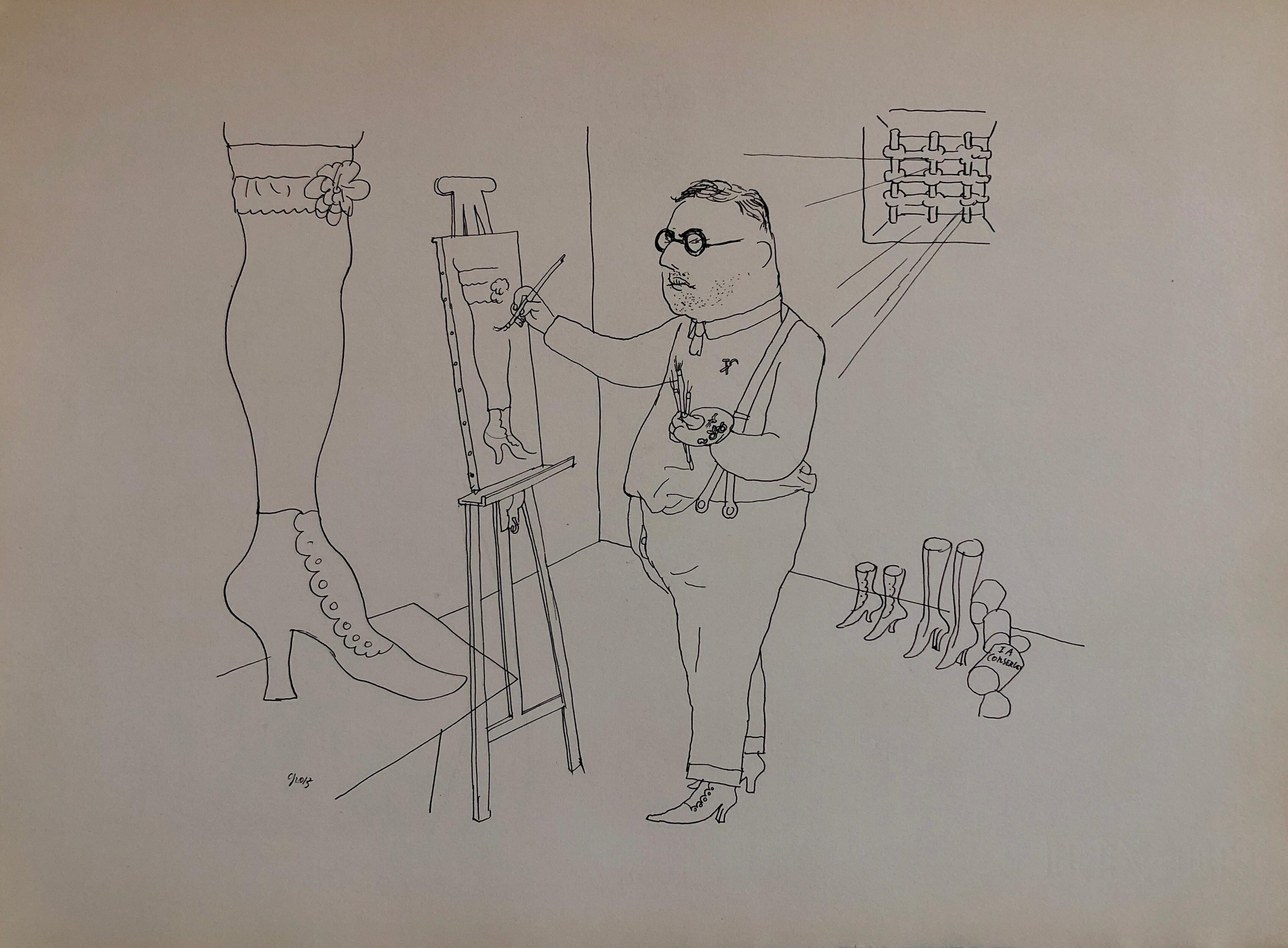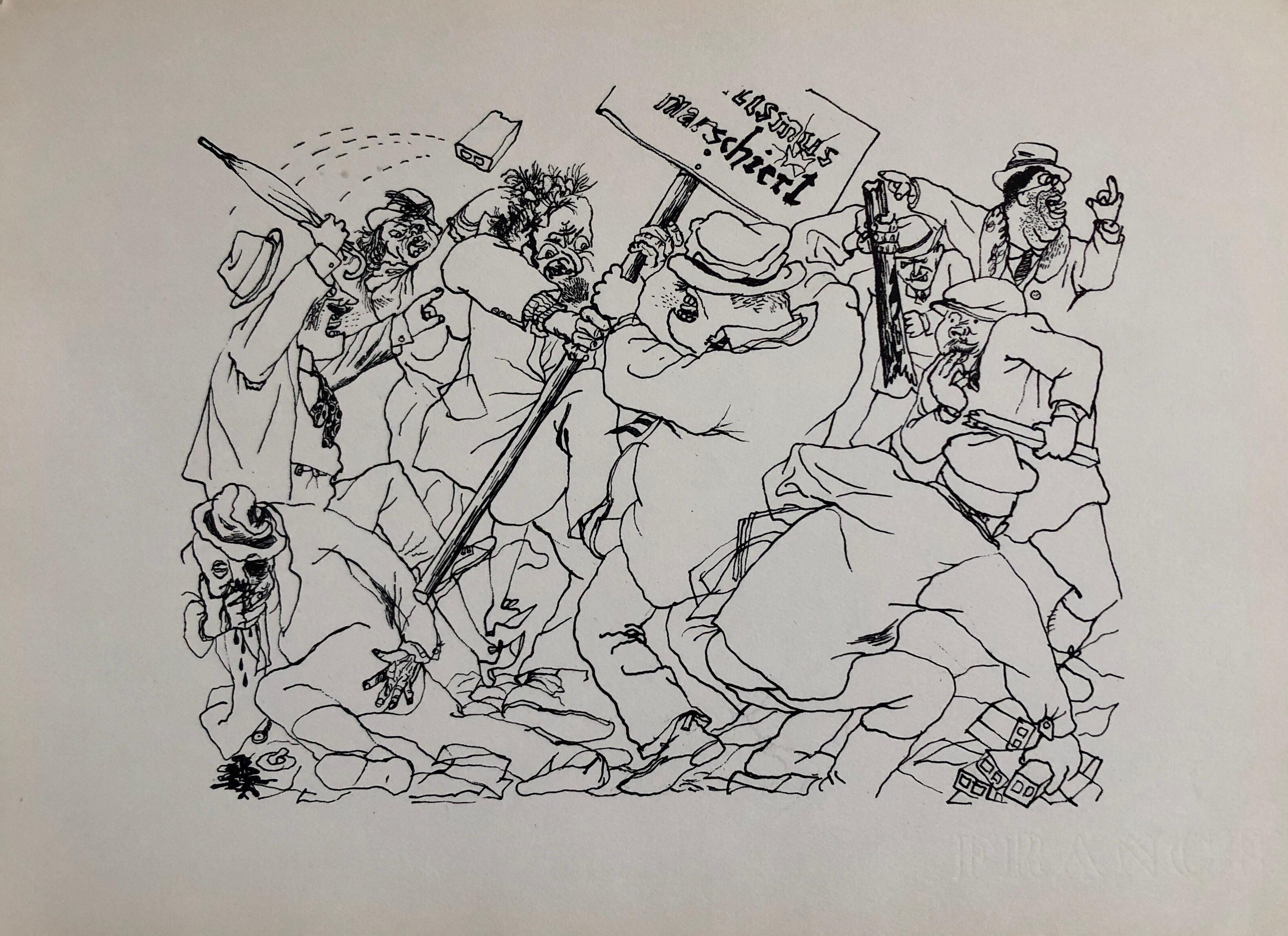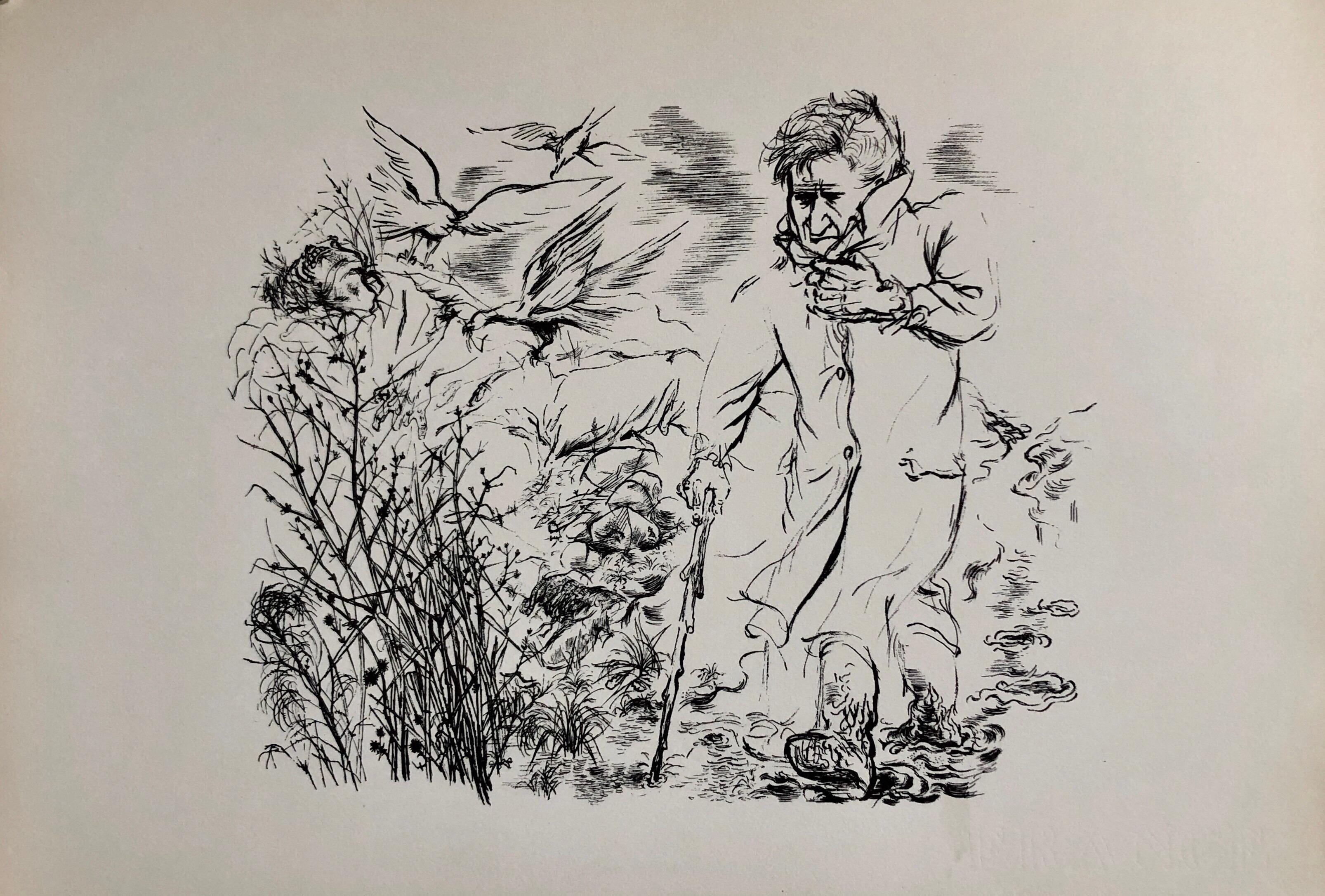Items Similar to Chapel of the Agricultural School, Chapingo (Ceiling Detail, Workers)
Want more images or videos?
Request additional images or videos from the seller
1 of 7
(after) Diego RiveraChapel of the Agricultural School, Chapingo (Ceiling Detail, Workers)1933
1933
About the Item
(after) Diego Rivera
"Chapel of the Agricultural School, Chapingo" (Ceiling Detail, Workers) 1933
from the portfolio "Frescoes of Diego Rivera"
Published by the Museum of Modern Art, NY
Size with the Matt: 18.5 x 13.5 inches
Hand-Signed by the Artist
Diego Rivera was born on December 13, 1886 in the mountain town of Guanajuato in Mexico. His mother was an ardent Catholic and his father was a rich and aristocratic revolutionary fighter and an atheist. Little Diego decided in favor of atheism. He swore his family had to leave Guanajuato when he was six because of his diatribes against the Church. When he was eleven he attended the San Carlos Academy of Fine Arts; his real teacher was Jose Posada, whose printmaking shop stood near the school.
At the age of twenty he won a traveling scholarship and spent the next three years in
museums and painting in Europe, expressing little of what he felt. In 1910 he returned to Mexico and became involved in the revolution that ended with the forcing out of office the aging dictator Diaz. In 1911 his scholarship was renewed and he sailed for Europe again, this time for a period of ten years. In Paris, he set up housekeeping with a pretty Russian blonde named Angeline Beloff, his first common-law wife; from her he learned the Russian language and from her friends he learned all about Marxism. He also learned about Cubism and Picasso.
A trip to Italy gave him a chance to study Giotto, Uccello and Andrea del Castagno. In 1922 he returned again to Mexico and joined forces with two other revolutionaries, Siqueiros and Orozco. They formed a government-backed syndicate of artists who changed from easel painting to working on murals. In the next decade he did what was probably his greatest work: frescoes in Cuernavaca and in Chapingo, where his favorite model was Guadalupe Marin, a tempestuous olive-skinned beauty. They married and she bore him two daughters. He proved to be a master of figure composition, of space and light, of crowds of farm workers and battle scenes, etc.
In 1927 Rivera decided it was time for a visit of homage to Moscow; he met and sketched Stalin for which he was very honored. Later he did a complete reversal about Stalin. When he got home from Moscow he met and married a pretty art student named Frida Kahlo. They moved into her home in Coyoacan, a Mexico City suburb. Among their many guests was Leon Trotsky who lived with them for two years while he wrote a biography of Stalin, his enemy. Kahlo died in 1954 and not long after, Rivera married again; this time he married Emma Hurtado, a magazine publisher who also had a gallery dealing in Rivera paintings.
Rivera was notorious for his murals in which he openly expressed his opinions on many controversial subjects of the day. The most notorious of these was the one in Rockefeller Center which was reduced to dust by the Rockefeller family after Rivera refused to remove the painting of Lenin uniting the workers. Rivera also worked hard at painting society portraits by the dozen; he did very popular flower paintings, sexy nudes and typical Mexican scenes. He painted the beautiful Dolores Del Rio and Paulette Goddard, the movie actress who posed for him at least twelve times. He made a lot of money which he got rid of as fast as he could make it. He was known as the softest touch in all of Mexico, giving away money to friends, guests and street beggars. He died in Mexico City on November 24, 1957.
- Creator:(after) Diego Rivera (1886 - 1957, Mexican)
- Creation Year:1933
- Dimensions:Height: 13.5 in (34.29 cm)Width: 18.5 in (46.99 cm)
- Medium:
- Movement & Style:
- Period:
- Condition:
- Gallery Location:Missouri, MO
- Reference Number:1stDibs: LU74732828073
(after) Diego Rivera
Diego Rivera was a prominent Mexican painter. His large frescoes helped establish the mural movement in Mexican and international art. Rivera was born as one of the twin boys in Guanajuato, Mexico, to María del Pilar Barrientos and Diego Rivera Acosta, a well-to-do couple. His twin brother Carlos died two years after they were born. They were said to have Converso ancestry. After moving to Paris, Rivera met Angelina Beloff, an artist from the pre-Revolutionary Russian Empire. They married in 1911 and had a son, Diego (1916–1918), who died young. Rivera died in Mexico City on November 24, 1957.
About the Seller
5.0
Vetted Seller
These experienced sellers undergo a comprehensive evaluation by our team of in-house experts.
Established in 1970
1stDibs seller since 2017
141 sales on 1stDibs
Typical response time: 22 hours
- ShippingRetrieving quote...Ships From: Missouri, MO
- Return PolicyA return for this item may be initiated within 2 days of delivery.
More From This SellerView All
- Chapel of the Agriculture School, Chapingo (Forces Under the Earth)By (after) Diego RiveraLocated in Missouri, MO(after) Diego Rivera "Chapel, Agriculture School, Chapingo" (Forces Under the Earth) 1933 from the portfolio "Frescoes of Diego Rivera" Published by the Museum of Modern Art, NY Approx. 18.5 x 13.5 with Matting Hand-Signed by the Artist Diego Rivera was born on December 13, 1886 in the mountain town of Guanajuato in Mexico. His mother was an ardent Catholic and his father was a rich and aristocratic revolutionary fighter and an atheist. Little Diego decided in favor of atheism. He swore his family had to leave Guanajuato when he was six because of his diatribes against the Church. When he was eleven he attended the San Carlos Academy of Fine Arts; his real teacher was Jose Posada...Category
1930s Modern Figurative Prints
MaterialsLithograph
- Don JuanBy Louis IcartLocated in Missouri, MOAquating Engraving Image Size: approx. 20 1/4 x 13 3/8 Framed Size: 28 x 20.5 inches Pencil Signed Lower Right Louis Justin Laurent Icart was born in Toulouse in 1890 and died in Paris in 1950. He lived in New York City in the 1920s, where he became known for his Art-Deco color etchings of glamourous women. He was first son of Jean and Elisabeth Icart and was officially named Louis Justin Laurent Icart. The use of his initials L.I. would be sufficient in this household. Therefore, from the moment of his birth he was dubbed 'Helli'. The Icart family lived modestly in a small brick home on rue Traversière-de-la-balance, in the culturally rich Southern French city of Toulouse, which was the home of many prominent writers and artists, the most famous being Henri de Toulouse-Lautrec. Icart entered the l'Ecole Superieure de Commerce de Toulouse in order to continue his studies for a career in business, particularly banking (his father's profession). However, he soon discovered the play writings of Victor Hugo (1802-1885), which were to change the course of his life. Icart borrowed whatever books he could find by Hugo at the Toulouse library, devouring the tales, rich in both romantic imagery and the dilemmas of the human condition. It was through Icart's love of the theater that he developed a taste for all the arts, though the urge to paint was not as yet as strong for him as the urge to act. It was not until his move to Paris in 1907 that Icart would concentrate on painting, drawing and the production of countless beautiful etchings, which have served (more than the other mediums) to indelibly preserve his name in twentieth century art history. Art Deco, a term coined at the 1925 Paris Exposition des Arts Decoratifs, had taken its grip on the Paris of the 1920s. By the late 1920s Icart, working for both publications and major fashion and design studios, had become very successful, both artistically and financially. His etchings reached their height of brilliance in this era of Art Deco, and Icart had become the symbol of the epoch. Yet, although Icart has created for us a picture of Paris and New York life in the 1920s and 1930s, he worked in his own style, derived principally from the study of eighteenth-century French masters such as Jean Antoine Watteau, François Boucher and Jean Honoré Fragonard. In Icart's drawings, one sees the Impressionists Degas...Category
1920s Art Deco Figurative Prints
MaterialsEngraving, Aquatint
- Chapel, Agriculture School, ChapingoBy (after) Diego RiveraLocated in Missouri, MO(after) Diego Rivera "Chapel, Agriculture School, Chapingo" 1933 from the portfolio "Frescoes of Diego Rivera" Published by the Museum of Modern Art, NY Approx. 18.5 x 13.5 with Matting Hand-Signed by the Artist Diego Rivera was born on December 13, 1886 in the mountain town of Guanajuato in Mexico. His mother was an ardent Catholic and his father was a rich and aristocratic revolutionary fighter and an atheist. Little Diego decided in favor of atheism. He swore his family had to leave Guanajuato when he was six because of his diatribes against the Church. When he was eleven he attended the San Carlos Academy of Fine Arts; his real teacher was Jose Posada...Category
1930s Modern Interior Prints
MaterialsLithograph
- The Blue BicycleBy Will BarnetLocated in Missouri, MOThe Blue Bicycle, 1979 Will Barnet (American, 1911-2012) 26 x 25.5 inches 41 x 40 inches with frame Titled Lower Center Signed and Dated Lower Right Edition 41/300 Lower Left From B...Category
1970s American Modern Figurative Prints
MaterialsLithograph
- U.S. Open at OakmontBy LeRoy NeimanLocated in Missouri, MOU.S. Open at Oakmont Leroy Neiman (American, 1921-2012) Signed in pencil lower right Edition 63/300 lower left 27.5 x 39 inches 39.25 x 51 inches with frame Known for his bright, co...Category
20th Century American Modern Landscape Prints
MaterialsColor, Lithograph
- Cove at VintageBy LeRoy NeimanLocated in Missouri, MOCove at Vintage Leroy Neiman (American, 1921-2012) Signed in pencil lower right Edition 237/375 lower left 34 x 36.5 inches 43 x 45.5 inches with frame Known for his bright, colorfu...Category
20th Century American Modern Landscape Prints
MaterialsColor, Lithograph
You May Also Like
- Lifting an Inner Tube.By Sir George ClausenLocated in Storrs, CT25 x 20 1/2. Series: "Making Guns" published by the Stationary Office as part of the series, The Great War: Britain's Efforts and Ideals. Edition 200. A fine impression pri...Category
Early 20th Century Modern Figurative Prints
MaterialsLithograph
- 1936 Lithograph Interregnum, Cigar, Kid w Toy Gun, Small Edition Weimar GermanyBy George GroszLocated in Surfside, FLHand lithography on BFK Rives French hand moulded paper Style: German New Objectivity (Neue Sachlichkeit) According to the frontis these were produced by Hand Lithography. According...Category
1930s Modern Interior Prints
MaterialsLithograph
- 1936 Lithograph Interregnum Portfolio Butcher Shop Small Edition Weimar GermanyBy George GroszLocated in Surfside, FLHand lithography on BFK Rives French hand moulded paper Style: German New Objectivity (Neue Sachlichkeit) According to the frontis these were produced by Hand Lithography. According...Category
1930s Modern Interior Prints
MaterialsLithograph
- 1936 Lithograph Interregnum portfolio Artist Studio small edition Weimar GermanyBy George GroszLocated in Surfside, FLHand lithography on BFK Rives French hand moulded paper Style: German New Objectivity (Neue Sachlichkeit) According to the frontis these were produced by Hand Lithography. According...Category
1930s Modern Interior Prints
MaterialsLithograph
- 1936 Lithograph Interregnum Street Riot Protest Small Edition Weimar GermanyBy George GroszLocated in Surfside, FLHand lithography on BFK Rives French hand moulded paper Style: German New Objectivity (Neue Sachlichkeit) According to the frontis these were produced by Hand Lithography. According...Category
1930s Modern Interior Prints
MaterialsLithograph
- 1936 Lithograph Interregnum Portfolio Windblown Man Small Edition Weimar GermanyBy George GroszLocated in Surfside, FLHand lithography on BFK Rives French hand moulded paper Style: German New Objectivity (Neue Sachlichkeit) According to the frontis these were produced by Hand Lithography. According...Category
1930s Modern Interior Prints
MaterialsLithograph
Recently Viewed
View AllMore Ways To Browse
Long Ceiling Light
Paris Ceiling
1939 Ceiling Light
Picasso 1933
Italian Hand Painted Prints Sets
The One That Got Away
Diego Rivera Print
Diego Rivera Vintage Prints
Picasso Lithograph Mother
Mexican Revolution
Two Fridas
Paris Street Scene Lithograph
Italian Space Age Ceiling Light
Russian Farm
Picasso Flower Print
Lenin Art
Vintage Catholic Church
Leon Little
